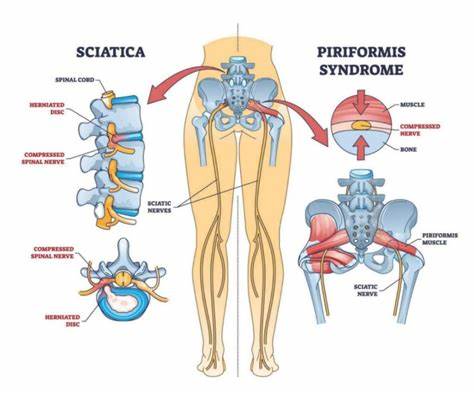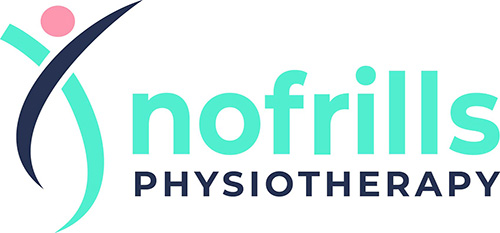Services
Sciatica
You might be experiencing sciatica if you’re feeling shooting pain that travels from your buttock down to your toes. This term refers to pain along the sciatic nerve, commonly linked to a herniated or slipped disc in the lower back.
What is Sciatica?
The sciatic nerve is the largest and longest nerve in the body, measuring nearly 2 cm in diameter. It originates from the sacral plexus, a network of nerves in the pelvic region, and branches down into each leg.
This nerve serves two primary functions: motor (movement) and sensory (feeling). When the nerve becomes compressed, it leads to a condition known as sciatica. In addition to sharp, shooting pain, individuals may also experience symptoms like loss of reflexes, weakness, and numbness when both motor and sensory functions are affected.

What are the symptoms?
You may experience one or more of the following sensations due to sciatica:
- Pain in the lower back or leg that worsens when sitting
- Burning or tingling sensations down the leg
- Weakness, numbness, or difficulty moving the leg or foot
- A constant ache on one side of the lower back
- Sharp pain that makes it difficult to stand up
If you experience severe pain accompanied by bowel or bladder control issues, treat it as an emergency and seek immediate evaluation from a neurologist or orthopedic specialist.
What Causes Sciatica?
One common cause of sciatica is a herniated disc, often referred to as a “slipped disc.” When a disc herniates, it protrudes and puts pressure on the nerve root that connects to the sciatic nerve. Given that the sciatic nerve is the longest nerve in the body, there are several ways it can become compressed, including:
Piriformis Syndrome
Piriformis Syndrome occurs when the piriformis muscle, located in the buttock, becomes inflamed or irritated. This muscle lies directly on top of the sciatic nerve as it exits the spine and travels down the leg. When the piriformis muscle is inflamed, it can swell and put pressure on the sciatic nerve, leading to symptoms similar to sciatica.
Spinal Stenosis
Spinal stenosis, the narrowing of the spinal canal, can lead to symptoms similar to sciatica. This narrowing may result from disc issues or arthritis in the spine, which can compress the sciatic nerve and cause pain, tingling, or weakness in the legs.
Sacroiliitis
Sacroiliitis is the inflammation of the sacroiliac joint, where the hip connects to the spine. This inflammation, often resulting from trauma or arthritis, can produce symptoms similar to sciatica, including pain in the lower back and legs.
Lumbar Facet Joint Syndrome
Lumbar Facet Joint Syndrome refers to pain originating from the facet joints in your lower back. This condition not only leads to discomfort in the back but can also produce symptoms similar to sciatica. Like other joints in the body, such as the knee or elbow, the facet joints can become inflamed, resulting in pain and restricted movement.
Iliolumbar Syndrome
Iliolumbar Syndrome involves inflammation or a tear of the iliolumbar ligament, which connects the spine to the iliac crest at the back of the pelvis. This condition can lead to localized pain in the lower back and may contribute to discomfort in the surrounding areas.
Our available treatments for shoulder pain
Nerve pain arises from a combination of pressure and inflammation on the nerve root. Therefore, treatment focuses on alleviating both of these contributing factors:
Manual Treatment
Manual treatments for sciatica include physiotherapy techniques like mobilization and manipulation to relieve pressure and inflammation. These may be complemented by electrophysical agents to enhance recovery.
Medical Treatment
Medical treatments for sciatica may include nonsteroidal anti-inflammatory drugs (NSAIDs), oral steroids, or epidural steroid injections to reduce inflammation and alleviate pain.
Surgery
Surgery for sciatica, such as microdiscectomy or lumbar laminectomy, may be necessary if the sciatic nerve pain is severe and does not improve with appropriate manual or medical treatments. These procedures aim to relieve both pressure on the nerve and inflammation.
Office
279 Tanjong Katong Road
Singapore 437062
Monday to Friday : 9am – 8pm
Saturday : 10am – 7pm
Sunday : 10am – 6pm
Services
Knee Pain
Shoulder Pain
Neck Pain
Elbow and Wrist Pain
Ankle and Foot Pain
Stretch Therapy
Sports Therapy
Women's Health
Contact
(+65) 9007 1085
hello@nofrillsphysiotherapy.com
Address: 279 Tanjong Katong Road
Singapore 437062
Other Physiotherapy Services
Shockwave Therapy
Dry Needling
Sports Massage
Functional Fitness
Workplace Health
